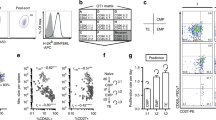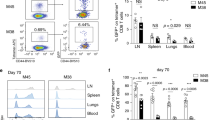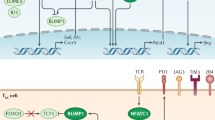Abstract
Whether memory T lymphocytes are derived directly from effector T cells or via a separately controlled pathway has long been debated. Here we present evidence that, after adoptive transfer, a large fraction of in vitro–derived effector CD4+ T cells have the potential to become memory T cells and that this transition can occur without further division. This data supports a linear pathway from effector to memory cells and suggests that most properties of memory cells are predetermined during effector generation. We suggest, therefore, that evaluation of vaccine efficacy in the induction of memory CD4+ T cells should focus on the effector stage.
This is a preview of subscription content, access via your institution
Access options
Subscribe to this journal
Receive 12 print issues and online access
$209.00 per year
only $17.42 per issue
Buy this article
- Purchase on Springer Link
- Instant access to full article PDF
Prices may be subject to local taxes which are calculated during checkout





Similar content being viewed by others
References
Swain, S. L., Hu, H. & Huston, G. Class II-independent generation of CD4 memory T cells from effectors. Science 286, 1381–1383 (1999).
Swain, S. L. Generation and in vivo persistence of polarized Th1 and Th2 memory cells. Immunity 1, 543–552 (1994).
Bruno, L., Kirberg, J. & von Boehmer, H. On the cellular basis of immunological T cell memory. Immunity 2, 37–43 (1995).
McHeyzer-Williams M. G. & Davis, M. M. Antigen-specific development of primary and memory T cells in vivo. Science 268, 106–111 (1995).
Liu, Y., Wenger, R. H., Zhao, M. & Nielsen, P. Distinct costimulatory molecules are required for the induction of effector and memory cytotoxic T lymphocytes. J. Exp. Med. 185, 251–262 (1997).
Cerwenka, A., Carter, L. L., Ream, J. B., Swain, S. L. & Dutton, R.W. In vivo persistence of CD8 polarized T cell subsets producing type 1 or type 2 cytokines. J. Immunol. 161, 97–105 (1998).
Opferman, J. T., Ober, B. T. & Ashton-Rickardt, P. G. Linear differentiation of cytotoxic effectors into memory T lymphocytes. Science 283, 1745–1748 (1999).
Jacob, J. & Baltimore, D. Modeling T-cell memory by genetic marking of memory T cells in vivo. Nature 399, 593–597 (1999).
Farber, D. L. Differential TCR signaling and the generation of memory T cells. J. Immunol. 160, 535–539 (1998).
Ahmadzadeh, M., Hussain, S. F. & Farber, D. L. Effector CD4 T cells are biochemically distinct from the memory subset: Evidence for long-term persistence of effectors in vivo. J. Immunol. 163, 3053–3063 (1999).
Pihlgren, M., Dubois, P. M., Tomkowiak, M., Sjogren, T. & Marvel, J. Resting memory CD8+ T cells are hyperreactive to antigenic challenge in vitro. J. Exp. Med. 184, 2141–2151 (1996).
Topham, D. J., Tripp, R. A., Hamilton-Easton, A. M., Sarawar, S. R. & Doherty, P. C. Quantitative analysis of the influenza virus-specific CD4+ T cell memory in the absence of B cells and Ig. J. Immunol. 157, 2947–2952 (1996).
Swain, S. L. et al. From naïve to memory T cells. Immunol. Rev. 150, 143–167 (1996).
Ahmed, R. & Gray, D. Immunological memory and protective immunity: Understanding their relation. Science 272, 54–60 (1996).
Sprent, J. Immunological memory. Curr. Opin. Immunol. 9, 371–379 (1997).
Dutton, R. W., Bradley, L. M. & Swain, S. L. T cell memory. Annu. Rev. Immunol. 16, 201–223 (1998).
Rogers, P. R., Dubey, C. & Swain, S. L. Qualitative changes accompany memory T cell generation: Faster, more effective responses at lower doses of antigen. J. Immunol. 164, 2338–2346 (2000).
Garcia, S., DiSanto, J. & Stockinger, B. Following the development of a CD4 T cell response in vivo: From activation to memory formation. Immunity 11, 163–171 (1999).
Dubey, C., Croft, M. & Swain, S. L. Costimulatory requirements of na?ve CD4+ T cells: ICAM-1 or B7–1 can costimulate naïve CD4 T cell activation but both are required for optimum response. J. Immunol. 155, 45–57 (1995).
Rogers, P. R., Huston, G. & Swain, S. L. High antigen density and IL-2 are required for generation of CD4 effectors secreting Th1 rather than Th0 Cytokines. J. Immunol. 161, 3844 (1998).
Swain, S. L. Helper T cell differentiation. Curr. Opin. Immunol. 11, 180–185 (1999).
Szabo, S. J. et al. A novel transcription factor, T-bet, directs Th1 lineage commitment. Cell. 100, 655–669 (2000).
Ouyang, W. et al. STAT6-independent GATA-3 autoactivation directs IL-4 independent Th2 development and commitment. Immunity 12, 27–37 (2000).
Bix, M. & Locksley, R. M. Independent and epigenetic regulation of the interleukin-4 alleles in CD4+ T cells. Science 281, 1352–1354 (1998).
Fitzpatrick, D. R. et al. Distinct methylation of the interferon γ (IFN-γ) and interleukin 3 (IL-3) genes in newly activated primary CD8+ T lymphocytes: regional IFN-γ promoter demethylation and mRNA expression are heritable in CD44(high)CD8+ T cells. J. Exp. Med. 188, 103–117 (1998).
Agarwal, S. & Rao, A. Modulation of chromatin structure regulates cytokine gene expression during T cell differentiation. Immunity 9, 765–775 (1998).
Agarwal, S., Avni, O. & Rao, A. Cell-type-restricted binding of the transcription factor NFAT to a distal IL-4 enhancer in vivo. Immunity 12, 643–652 (2000).
Bird, J. J. et al. Helper T cell differentiation is controlled by the cell cycle. Immunity 9, 229–237 (1998).
Richter, A., Lohing, M. & Radbruch, A. Instruction for cytokine expression in T helper lymphocytes in relation to proliferation and cell cycle progression. J. Exp. Med. 190, 1439–1450 (1999).
Fitzpatrick, D. R., Shirley, K. M. & Kelso, A. Stable epigenetic inheritance of regional IFN-γ promoter demethylation in CD44high CD8+ T lymphocytes. J. Immunol. 162, 5053–5057 (1999).
Viret, C., Wong, F. S. & Janeway, C. A. Designing and maintaining the mature TCR repertoire: the continuum of self-peptide: self-MHC complex recognition. Immunity 10, 559–568 (1999).
Ernst, B., Lee, D. S., Chang, J. M., Sprent, J. & Surh, C. D. The peptide ligands mediating positive selection in the thymus control T cell survival and homeostatic proliferation in the periphery. Immunity 11, 173–181 (1999).
Lee, W. T. & Pelletier, W. J. Visualizing memory phenotype development after in vitro stimulation of CD4 T cells. Cell. Immunol. 188, 1–11 (1998).
Zhang, X. et al. Unequal death in Th1 and Th2 effectors: Th1 but not Th2 effectors undergo rapid Fas/FasL-mediated apoptosis. J. Exp. Med. 185, 1837–1849 (1997).
Harbertson, J., Biederman, E., Bennet, K. E., Kondrack, R. M. & Bradley, L, M. Withdrawal of stimulation may initiate the transition of effector to memory cells. J. Exp. Med. (submitted, 2001).
Bradley, L. M., Duncan, D. D., Tonkonogy, S. & Swain, S. L. Characterization of antigen-specific CD4+ effector T cells in vivo: immunization results in a transient population of MEL-14−, CD45RB− helper cells that secretes interleukin 2 (IL-2), IL-3, IL-4, and interferon γ. J. Exp. Med. 174, 547–559 (1991).
Jelley-Gibbs, D. M., Lepak, N., Yen, M. & Swain, S.L. Two distinct stages in the transition from naïve CD4 T cells to effectors, early antigen dependent and late cytokine driven expansion and differentiation. J. Immunol. 165, 5017–5026 (2000).
Veiga-Fernandes, H., Walter, U., Bourgeois, C., McLean, A. & Rocha, B. Response of naïve and memory CD8+ T cells to antigen stimulation in vivo. Nature Immunol. 1, 47–53 (2000).
Cerwenka, A., Morgan, T. M. & Dutton, R. W. Naïve, effector, and memory CD8 T cells in protection against pulmonary influenza virus infection: Homing properties rather than initial frequencies are crucial. J. Immunol. 163, 5535–5543 (1999).
Selin, L. K. et al. Attrition of T cell memory: Selective loss of LCMV epitope-specific memory CD8 T cells following infections with heterologous viruses. Immunity 11, 733–742 (1999).
Whitmire J. K., Murali-Krishna, K., Altman, J. & Ahmed, R. Antiviral CD4 and CD8 T-cell memory: differences in the size of the response and activation requirements. Phil. Trans. R. Soc. Lond. B 355, 373–379 (2000).
Zhang, X., Sun, S., Hwang, I., Tough, D. F. & Sprent, J. Potent and selective stimulation of memory-phenotype CD8+ T cells in vivo by IL-15. Immunity 8, 591–599 (1998).
Ku, C. C., Murakami, M., Sakamoto, A., Kappler, J. & Marrack, P. Control of homeostasis of CD8+ memory T cells by opposing cytokines. Science 288, 675–678 (2000).
Kaye, J. et al. Selective development of CD4+ T cells in transgenic mice expressing a class II MHC-restricted antigen receptor. Nature 341, 746–749 (1989).
Rooke, R., Waltzinger, C., Benoist, C. & Mathis, D. Targeted complementation of MHC class II deficiency by intrathymic delivery of recombinant adenoviruses. Immunity 7, 123–134 (1997).
Haynes, L., Linton, P-J., Eaton, S. M., Tonkonogy, S. L. & Swain, S. L. Interleukin-2, but not other common γ chain-binding cytokines, can reverse the defect in generation of CD4 effector T cells from naïve cells of aged mice. J. Exp. Med. 190, 1013–1023 (1999).
Author information
Authors and Affiliations
Corresponding author
Rights and permissions
About this article
Cite this article
Hu, H., Huston, G., Duso, D. et al. CD4+ T cell effectors can become memory cells with high efficiency and without further division. Nat Immunol 2, 705–710 (2001). https://doi.org/10.1038/90643
Received:
Accepted:
Issue Date:
DOI: https://doi.org/10.1038/90643
This article is cited by
-
CD80 and PD-L2 define functionally distinct memory B cell subsets that are independent of antibody isotype
Nature Immunology (2014)
-
Human CD4+ effector T lymphocytes generated upon TCR engagement with self-peptides respond defectively to IL-7 in their transition to memory cells
Cellular & Molecular Immunology (2013)
-
Lung myeloid-derived suppressor cells and regulation of inflammation
Immunologic Research (2011)
-
Evidence of STAT5‐dependent and ‐independent routes to CD8 memory formation and a preferential role for IL‐7 over IL‐15 in STAT5 activation
Immunology & Cell Biology (2010)
-
TLR4/MyD88-induced CD11b+Gr-1intF4/80+ non-migratory myeloid cells suppress Th2 effector function in the lung
Mucosal Immunology (2010)



